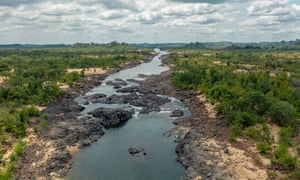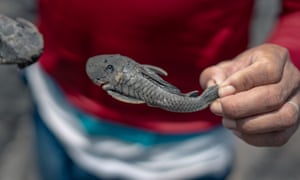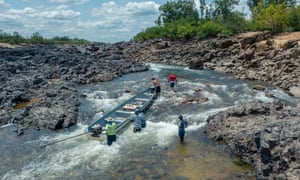Poorly planned Amazon dam project 'poses serious threat to life'
Operator faces choice of weakening 14km barrier or potentially devastating a biodiversity hotspot
by Jonathan Watts in Belo Monte
The biggest hydroelectric project in the Amazon rainforest has a design flaw that poses a “very serious” threat to human life and globally important ecosystems, according to documents and expert testimony received by the Guardian.
The studies suggest engineers failed to anticipate the impact of water shortages on the Pimental dam at Belo Monte, which has been closed and turned into a barrier. This is forcing the operators to choose between a structural weakening of the 14km-wide compacted-earth barrier and a reallocation of water in the reservoir or on the Xingu river, which is home to indigenous communities, fishing villages and some of the world’s most endangered species.
One analyst said there was risk of a rupture, and even before the report was issued federal prosecutors were preparing to call for the project to be suspended. They also intend to appeal to the Brazilian government for emergency humanitarian aid to support riverine populations that have experienced a devastating decline of fish on which they depend for nutrition and income.
After decades of resistance and 40bn reais (£8bn) of investment, the world’s fourth biggest hydropower plant is due to have the last of its 18 turbines installed this month, but lower-than-forecast water levels in the dam’s reservoirs have created an unforeseen structural problem in addition to longstanding environmental, social and economic concerns.
The Guardian and El País have seen a recent report by Norte Energia which warned that the fall in water levels in recent weeks has exposed a vulnerable section of the Pimental dam wall, which is separate from the barrier housing most of the turbines, to waves that sometimes form during tropical storms or strong winds blowing across the reservoir.
The 11 October document – Urgent action to control the level of the Belo Monte HPP Xingu Reservoir - is signed by Norte Energia’s CEO and addressed to the head of the national water agency. It says that water levels fell the previous day to a critical 95.2 metres, which posed a risk that waves “will reach areas of the dam not protected by rock” reinforcements. It asks permission for more water from the intermediate reservoir, a move which would put more pressure on an already strained hydrology.
Following two deadly tailings dam disasters in recent years at Brumadinho and Mariana, the uncertain situation has prompted experts to call on Brazilian authorities to increase monitoring of the dam, take remedial measures and clarify the magnitude of the risk to the public.
André Oliveira Sawakuchi of the department of sedimentary and environmental geology at the University of São Paulo said it was unclear whether structural damage might occur within weeks, months or years, but the report’s call for immediate action suggested the threat was very serious.
His concerns were echoed by Francisco del Moral Hernandez, an energy science specialist who coordinated an expert panel on Belo Monte in 2009. “We’ve always known this project is inefficient from the standpoint of power generation. What we did not imagine is the weakness of the civil engineering,” he said. “If I were living downstream of the dam, I would move upriver … It is absurd this was not foreseen.”

The report says the problem arose as a result of unusually low water flows into the reservoir, with several days in early October when it dropped to 750 cubic metres a second. This is substantially below the minimum of 1,000 cubic metres a second that planning documents say is needed to guarantee water quality in the reservoirs and sufficient downstream discharge to ensure a healthy ecosystem, including for a turtle refuge, and indigenous and riverine communities’ navigation.
Hernandez and Sawakuchi said planners had been over-optimistic because historical data showed the Xingu river was lower on at least four occasions during the 50 years before construction started. Climate change is projected to cut water flows by about 30% by 2050. “It’s very strange these problems weren’t foreseen,” Sawakuchi said. “The structural risks are a surprise.”
The Belo Monte project has been beset with problems since its inception during the era of Brazil’s military dictatorship. Indigenous and riverine communities allied to oppose the dam system, which blocks one of the Amazon’s biggest tributaries with 2.1m tonnes of concrete and 79.2m cubic metres of earth.

Environmentalists and scientists warned this would devastate one of the world’s most unique biodiversity hotspots. Economists questioned the viability of a scheme paid for with pension funds and tax revenues, but which is designed to run at only 40% of its 11,200MW capacity. Prosecutors involved in the Car Wash corruption investigation found Belo Monte contractors were paid inflated fees in return for kickbacks to political parties.
Activists said environmental authorities had issued a license to the dam despite scientific warnings and the concerns of their own technical staff. “As details of the corruption scandal have unfolded, the motivations underlying such reckless decisions have become abundantly clear, as well as their tragic consequences,” said Brent Millikan of International Rivers.
It is unclear whether more construction is needed to reinforce the Pimental dam wall, which would require a hefty additional investment. In the short term, the authorities face the dilemma of whether to accept the possible erosion of the dam wall or a further decline in water quality.
“That there is already a shortage of water calls into question the entire viability of Belo Monte hydroelectric project,” Thais Santi, the public prosecutor for Altamira, said. “This is a fault in the construction and the planning.”
She plans to send a formal request to the federal authorities in the coming days for immediate humanitarian assistance to affected residents and a suspension of the dam. She considers this a case of ecocide. “It is already apparent this project is a mistake,” she said. “As well as the death of a river, it will result in the death of people. There is already insufficient food in this area.”
The grim situation is apparent on a motor canoe ride along the volta grande, or great bend, of the Xingu river. Locals explain how the waterway is narrowing and becoming shallower. When we reach the Boca da Terra Preta waterfall, it is no longer navigable. On the exposed rocks are two dead acari fish that appear to have been trapped, desiccated and had their guts ripped out by vultures. On the river bank, sarao trees – which usually provide food for the abundant pacu fish are now so far back that their fruit no longer falls in the water. Fishing communities say their catches are down by between 50 and 80% since the river was dammed.

On a small island in the river, more than 50 locals arrived by boat last week to testify to the problems caused by the dam. As well as increasing hunger and lower incomes, several said they suffered depression as a result of the sudden collapse of the riverscape they had grown up with. “Everything is getting worse,” said Sarah Rodrigues de Lima. “I’ve been fishing here for 35 years but all the fish have fled. The river is drying up.”
Others described how they used to catch filhote, one of the most prized river species, weighing more than 100kg before the dam, but now rarely catch one of even 20kg. Next year is set to be even worse. This will be the start of a new water management system that will prioritise the dam and the ecosystem on alternate years. Even under its best scenario, the volta grande will get less peak rainy season water than during the severe drought of 2016, which killed so many fish that locals refer to it as the “year of the end of the world.” .
The new system “will turn the river into a cemetery”, said Cristiane Costa, a biologist working in the office of the public prosecutor. “They are generating energy at the cost of the ecosystem and people.”
Global heating will increase the struggle for water. The government, however, wants more exploitation of Amazonian resources. Brazil’s president, Jair Bolsonaro, who is reportedly planning to attend the completion ceremony for Belo Monte, has weakened protections for the environment and indigenous communities. Local politicians will urge him to push ahead with another mega-project in the volta grande, a giant new goldmine called Belo Sun, which would be powered by the dam.
Norte Energia said in a statement that it “strictly complies” with the conditions of its environmental license. The national water agency and the Brazilian Institute for the Environment and Renewable Natural Resources did not respond to the Guardian’s request for a comment.

